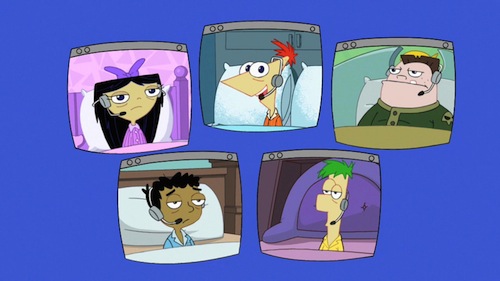
On the first full day of STARWest 2013, I ended up at home with my sick son. (Stomach bug. Boo.) Fortunately, most of the excitement had passed by morning and the day turned out to be blessedly restful, which was essential for this sleepy mom keeping vigil.
We rolled out of bed and sat on the couch watching a cartoon in companionable silence while I poked about on Twitter to find information on the morning’s Lean Coffee to attempt virtual attendance. Since it turned out to be a Google Hangout, my son became much more interested in paying attention, selecting various digital accessories for me – much to the amusement of the other attendees. (Son’s first Lean Coffee? Check. Wearing a digital monocle? Check. Winning at parenting? Check!)
As with any remote conferencing system I’ve ever used, the setup and logistics had their challenges, but I was happy to be included in the event in this small way. The one topic that I could clearly hear concerned sharing conference learnings after returning home.
The classic: presentation to the team.
Many people have blogged about writing – or presenting – a great trip report. Usually these start out with advice for writing your conference attendance proposal to include some language about teaching what you learn, perhaps at the prompting of your boss. At the conference, you take great notes, perhaps even writing up your report during a layover on the way home. Upon your return to the real world, still on a conference high, you set out the conquer your problems with the grand visions of a better work life only to confront business as usual… which you will somehow overcome in a single hour or two of lecturing? It’s a rude awakening. Somehow the top-down decision that the team will learn – from you. right now. – isn’t quite working out. So how do you overcome the resistance to change and really bring home useful lessons?
The subtle: solo experiments as exemplars.
A tactic I prefer is coming home with a list of things to try “on Monday” when I’m back in the office. I think of this as a series of small experiments. Matt suggests keeping these experiments isolated to your day-to-day work in order to improve results without running into the dreaded inertia of the system. As they say, big wheels turn slowly. I can certainly see his argument there since past attempts to suggest alternate approaches that radically changed others’ tasks haven’t really worked out for me. I feel a lot of ownership of my experiments and the experiences have opened up my thinking to additional new techniques, approaches, and strategies. Is your pen mightier than the the sword? Will your report really sway your audience? I certainly have tried this option in the past, but teams may find that approach tired, just one more meeting to attend.
How to bring conference learning back to the team? #leancoffee #starwest @mheusser does experiments solo. @g33klady is doing a presentation
— Claire Moss (@aclairefication) October 2, 2013
The novel: long and drawn out denouement.
The new shiny approach that I’m currently tackling is making connections among different presentations and topics to connect them in ways that seem particularly relevant to my work team’s context. My current experiment is a series of smaller presentations, complete with food and succinct snippets (the TL;DR) in emails that will link to blog posts (the deets). Gradual exposure seems better than bombarding a team with new information in a one-time brain dump. I just hope no one gets sick of my weekly missives!
I’m putting together Lunch-n-Learn presentations and weekly email/blogs to distribute. Less info dump, more learning #leancoffee #starwest
— Claire Moss (@aclairefication) October 2, 2013
As the conference delegates adjourned to attend the regular sessions, I remained sitting with my son. It might have been the exhaustion talking, but when he asked me for my mobile phone I gave in. Within minutes, he found an odd interaction (bug?) in the mobile Hangouts app and shortly afterward froze Angry Birds with a feathered missile in mid-arc. Natural born tester, I tell ya. Making his momma so proud it was easy to forget the sickness and fatigue.
Update from this morning’s Lean Coffee!
Going to use #LeanCoffee as the way to share what I’ve learned at #starwest with my team
— Hilary aka H-Bomb (@g33klady) October 3, 2013
Pingback: Five Blogs – 7 October 2013 | 5blogs